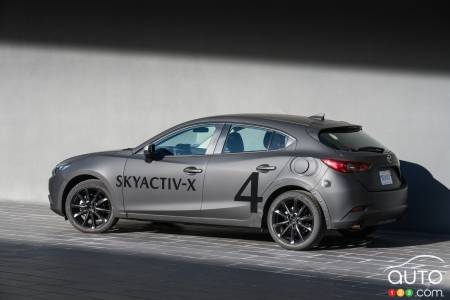Irvine, California—Back in 2007, Mazda unveiled its SKYACTIV-G program and set out a goal of reducing the fuel consumption of its engines by 20% by 2015. It also included developing new technologies touching on vehicle platforms, road handling and safety. All of the company’s goals were achieved.
Mazda followed up this success by getting to work developing a new program, this time with a completion target of 2030.
What is “Sustainable Zoom Zoom 2030”?
It’s worth noting that the Japanese company does not focus exclusively on the mechanics of its cars. Mazda’s brain-trust has long demonstrated a social conscience and worked to improve the planet’s environment as well as the daily life of the people who live on it. For example, it has always acknowledged that the electrification of the world’s vehicle fleets won’t happen overnight, and pointed to the aging of those fleets on every continent to warn that pollution levels are likely to rise before they decrease. In their view, a part of the solution certainly lies in producing vehicles that create the least amount of pollution, and to that end Mazda does intend to market hybrid and partially electric vehicles by 2019. However, the majority of its vehicles will continue to feature what most consumers buy: a traditional internal combustion engine. The goal of Mazda engineers is to make those engines pollute and consume as little as possible, with the ultimate objective of contributing to reducing overall pollution levels.
The company intends to reduce the polluting emissions of Mazda vehicles by 50% by 2030, and 90% by 2050. The first step on this ambitious road has been to develop an engine with unique technology, namely a compression-ignition combustion engine system, officially called “Spark-Controlled Compression Ignition”.
SKYACTIV-X technology
It would be easy to bury you under nerdy data in hopes of trying to impress you. What’s important to retain, however, is that the new engine technology innovates in a number of ways. During the technical presentation, Mazda’s engineers philosophized about the different ways to reduce the consumption of a combustion engine. In their view, the best way to reduce CO2 emissions and fuel consumption was to use a mixture very low in fuel and very high in oxygen.
Which is easy to say, of course, but hard to nail down in practice. Developing an efficient engine with this technology requires using a high compression rate, along the lines of a 16:1 ratio, sufficient to ignite the fuel with compression. In short, this technology is the same as a diesel engine whose air-fuel mixture is ignited by simple pressure on the piston in the combustion chamber.
But working with a gasoline engine, and needing to avoid uncontrolled combustion all while producing an engine that is smooth and performs well, the engineers at Mazda decided implant a small sparkplug that can ignite the air-fuel mixture as it arrives in the cylinder via direct injection by creating the initial sparks. The system then, depending on the conditions of use, relies on combustion ignition most of the time.
The technology makes use of the Miller valve system, which allows for a momentary overlap of the intake and exhaust valves to optimize the air-fuel ratio. A variant of this system is the Atkinson Cycle used in the majority of hybrid-engine cars. Mazda has actually successfully marketed a car fitted with this system, and its reliability was impeccable.
This configuration enables the production of higher torque than is possible with a conventional engine, thus also enabling quicker initial acceleration. What’s more (and without delving unduly into detail), this engine is capable of higher-than-average RPMs, which can be attained indefinitely according to the pilot’s driving style.
In order to homogenize the engine’s functioning, Mazda engineers used a low-flow compressor to optimize air-fuel ratio without any uncontrolled combustion.
The proof is on the road
Listening to the engineers talk about their labour of love is one thing, taking notes about it all is another; but the litmus test regarding the efficacy of such a mechanical setup is to hit the road at the wheel of cars equipped with this revolutionary engine. Setting out from the Mazda technical centre located in Irvine, California, we were able to do some road testing in urban and highway settings to evaluate the system. Half of the testing was at the wheel of a Mazda3 with automatic transmission, the other half in the same model but with a manual gearbox; both were 6-speeds.
It should be pointed out that these cars were prototypes of a sort and featured none of the luxury and comfort qualities of a normal Mazda3. That said, we did enjoy the high comfort levels provided by the new seats that will be used in the upcoming model; they provide excellent lumbar support. The rear bench is new as well, and we also noted improvements there.
The sound of the engine when idling is almost imperceptible, but the claims made by the automaker’s engineers are proven correct once out on the road. With a higher-torque engine, initial acceleration is more impressive, plus the engine continues to deliver strong acceleration and pick-up at all RPMs. What’s more, gear shifts are almost imperceptible, at least with the automatic transmission. This is an engine with promise, which should consume some 25-30% less fuel than the 2.0L engine in use in the current Mazda3.
The cars we drove were underpinned by Mazda’s improved new platform and suspension, resulting in pretty convincing road handling as well as much-improved comfort.
SKYACTIV-X in short
It makes for a promising beginning for this new stage in the process of developing future Mazda vehicles, at all levels but particularly in terms of reducing of CO2 emissions and fuel consumption while still improving the driving experience.
The Sustainable Zoom Zoom 2030 program is off and running!
[Ed. Note] Did you know that Mazda is the most fuel-efficient automaker in America for the fifth straight year according to the EPA? Also, don’t miss our latest Mazda reviews, from the Mazda3 Sport to the CX-9.







